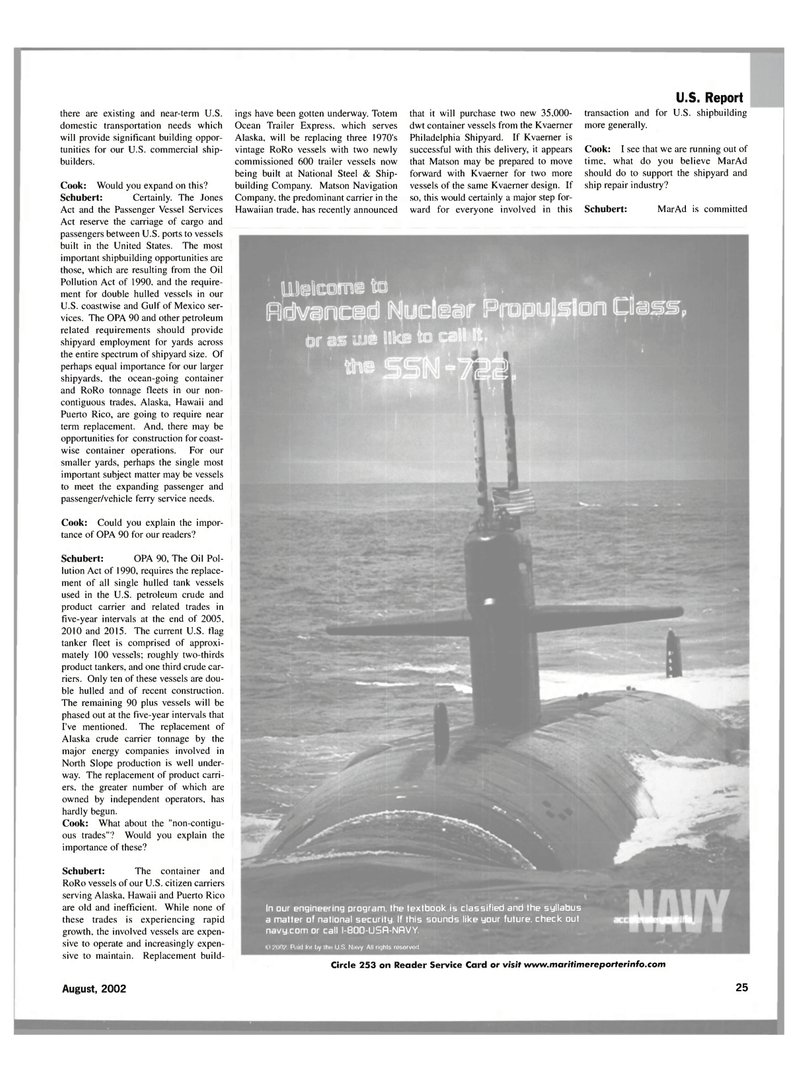
Page 27: of Maritime Reporter Magazine (August 2002)
Read this page in Pdf, Flash or Html5 edition of August 2002 Maritime Reporter Magazine
there are existing and near-term U.S. domestic transportation needs which will provide significant building oppor- tunities for our U.S. commercial ship- builders.
Cook: Would you expand on this?
Schubert: Certainly. The Jones
Act and the Passenger Vessel Services
Act reserve the carriage of cargo and passengers between U.S. ports to vessels built in the United States. The most important shipbuilding opportunities are those, which are resulting from the Oil
Pollution Act of 1990, and the require- ment for double hulled vessels in our
U.S. coastwise and Gulf of Mexico ser- vices. The OPA 90 and other petroleum related requirements should provide shipyard employment for yards across the entire spectrum of shipyard size. Of perhaps equal importance for our larger shipyards, the ocean-going container and RoRo tonnage fleets in our non- contiguous trades, Alaska, Hawaii and
Puerto Rico, are going to require near term replacement. And, there may be opportunities for construction for coast- wise container operations. For our smaller yards, perhaps the single most important subject matter may be vessels to meet the expanding passenger and passenger/vehicle ferry service needs.
Cook: Could you explain the impor- tance of OPA 90 for our readers?
Schubert: OPA 90, The Oil Pol- lution Act of 1990, requires the replace- ment of all single hulled tank vessels used in the U.S. petroleum crude and product carrier and related trades in five-year intervals at the end of 2005, 2010 and 2015. The current U.S. flag tanker fleet is comprised of approxi- mately 100 vessels; roughly two-thirds product tankers, and one third crude car- riers. Only ten of these vessels are dou- ble hulled and of recent construction.
The remaining 90 plus vessels will be phased out at the five-year intervals that
I've mentioned. The replacement of
Alaska crude carrier tonnage by the major energy companies involved in
North Slope production is well under- way. The replacement of product carri- ers, the greater number of which are owned by independent operators, has hardly begun.
Cook: What about the "non-contigu- ous trades"? Would you explain the importance of these?
Schubert: The container and
RoRo vessels of our U.S. citizen carriers serving Alaska, Hawaii and Puerto Rico are old and inefficient. While none of these trades is experiencing rapid growth, the involved vessels are expen- sive to operate and increasingly expen- sive to maintain. Replacement build- ings have been gotten underway. Totem
Ocean Trailer Express, which serves
Alaska, will be replacing three 1970's vintage RoRo vessels with two newly commissioned 600 trailer vessels now being built at National Steel & Ship- building Company. Matson Navigation
Company, the predominant carrier in the
Hawaiian trade, has recently announced that it will purchase two new 35,000- dwt container vessels from the Kvaerner
Philadelphia Shipyard. If Kvaerner is successful with this delivery, it appears that Matson may be prepared to move forward with Kvaerner for two more vessels of the same Kvaerner design. If so, this would certainly a major step for- ward for everyone involved in this
U.S. Report transaction and for U.S. shipbuilding more generally.
Cook: I see that we are running out of time, what do you believe MarAd should do to support the shipyard and ship repair industry?
Schubert: MarAd is committed
Circle 253 on Reader Service Card or visit www.maritimereporterinfo.com
In our engineering program, the textbook is classified and the syllabus a matter of national security. If this sounds like your future, check out navy.com or call 1-800-USR-NRVY. © 2002. Paid for by the US. Navy All rights reserved.
August, 2002 25

 26
26

 28
28
